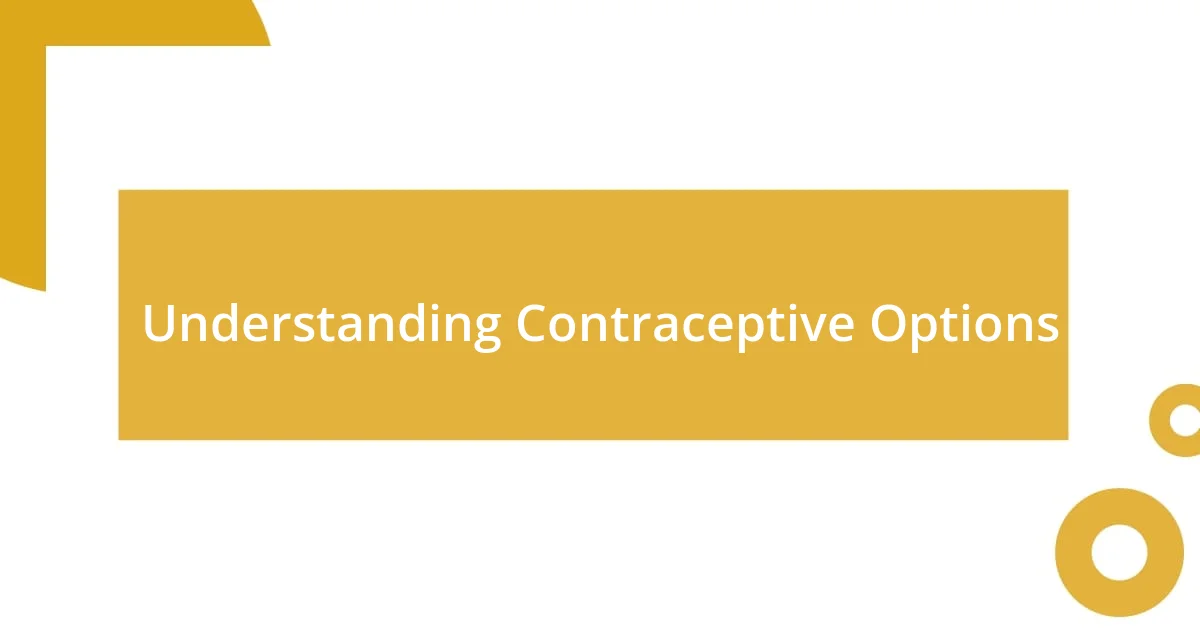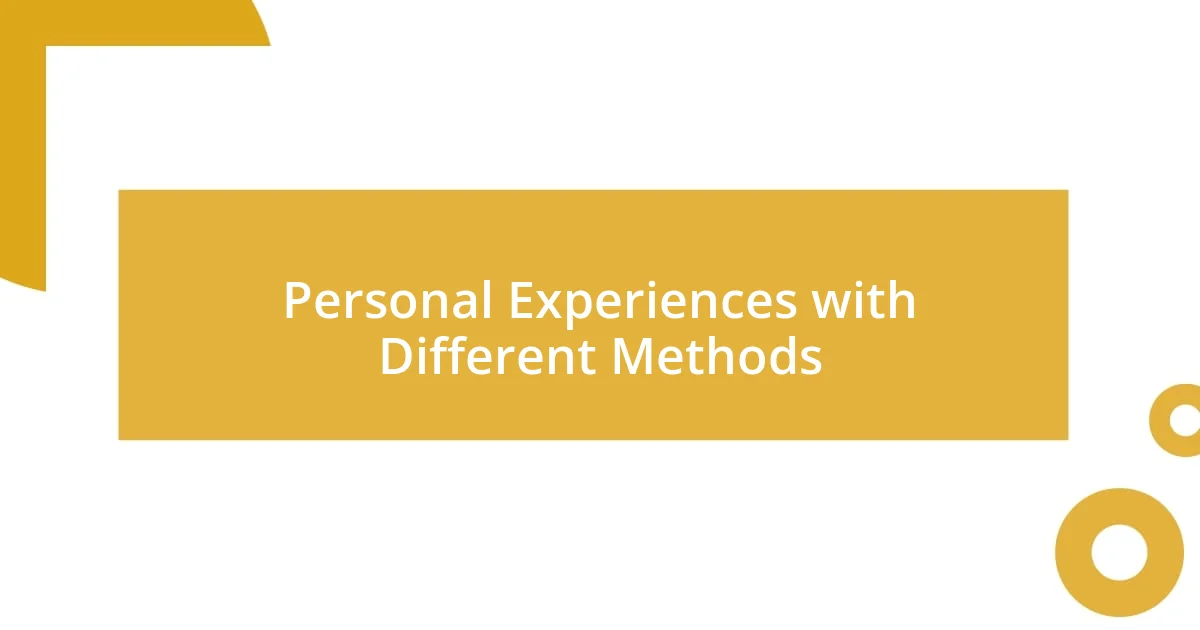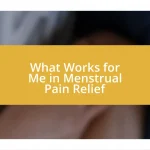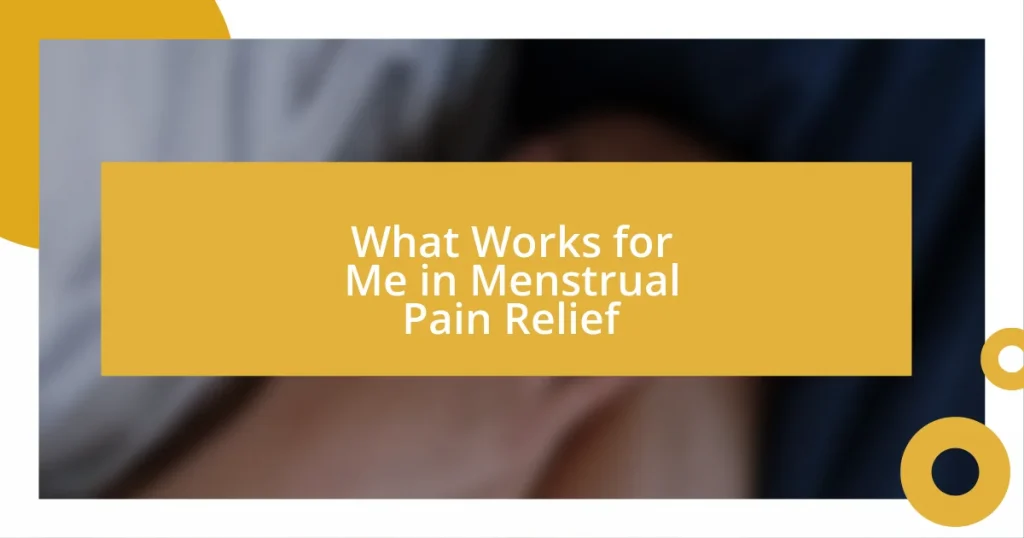Key takeaways:
- Choosing a contraceptive is a deeply personal decision, influenced by lifestyle preferences, emotional impacts, and individual health considerations.
- Researching contraceptive methods empowers individuals to make informed choices, emphasizing the importance of aligning methods with personal values and life goals.
- Experiencing different contraceptive options highlights the necessity of patience, self-awareness, and the potential for short-term discomfort to yield long-term benefits.

Understanding Contraceptive Options
When I first started exploring contraceptive options, I felt overwhelmed by the sheer variety available. There are hormonal methods, like pills and patches, as well as non-hormonal options such as copper IUDs, each with its own set of benefits and potential side effects. Have you ever wondered how one type might work better for you than another? I remember feeling hesitant about the hormonal options because of how they might affect my mood—something I didn’t want to risk.
As I dug deeper, I realized that understanding these options isn’t just about effectiveness; it’s also about lifestyle compatibility. For instance, I found that the pill required daily discipline, while the IUD provided long-term protection without consistent effort. Have you ever thought about what kind of routine fits your life best? I surely did, particularly when I juggled a busy schedule and my desire for spontaneity.
Talking to friends opened my eyes even further. Hearing their experiences ignited a mix of curiosity and concern. Some shared stories of unexpected side effects that made me reconsider my choices; others felt liberated by their selected method. It made me realize that there’s no one-size-fits-all solution—our bodies and lifestyles are unique. It’s vital to listen to both our instincts and the experiences of those around us as we weigh our options.

My Initial Thoughts on Contraceptives
When I first started considering contraceptives, I felt a mix of curiosity and anxiety. It wasn’t just about preventing pregnancy—there was a lot to think about regarding my body and how I wanted to manage my reproductive health. I vividly remember looking at different options and feeling a bit lost; there were so many choices, each promising its own unique benefits. I found myself asking, “Which one aligns with my lifestyle?”
As I weighed my options, I couldn’t shake off the fear of potential side effects. The stories friends shared about their experiences stuck with me. One friend had a tough time with the pill, experiencing frequent mood swings that changed her daily interactions. Hearing her made me acutely aware of how hormonal contraception could affect emotions, and it brought a surge of hesitance in me. This made me wonder if safety and mood stability could even coexist.
Ultimately, I began to realize that choosing a contraceptive is deeply personal. I remember chatting with my doctor, looking for reassurance. It felt empowering to discuss my concerns openly. I learned that I had to prioritize my comfort and trust my intuition in this decision-making process. Finding a method that didn’t just fit medically but also felt right emotionally was key; it taught me that contraceptive choices are more than just logistics—they’re intertwined with who we are and how we feel.
| Contraceptive Methods | Key Considerations |
|---|---|
| Pills | Daily commitment, potential mood changes |
| IUD | Long-term option, less daily management |
| Condoms | No hormonal interference, additional pregnancy protection |

Researching the Best Methods
As I dove into researching the best contraceptive methods, I quickly grasped that the landscape is incredibly diverse. It wasn’t just about reading the pros and cons; I found myself constantly evaluating how each option intersected with my personal values and lifestyle. I vividly recall digging through various resources online, taking notes as if I was preparing for an exam, and reaching out to healthcare professionals for clarity. The more I learned, the more I felt a gradual shift from uncertainty to a newfound sense of empowerment—a feeling I truly cherished. One common theme I encountered was the importance of aligning choices with my life goals.
Here’s how I broke down my research to make it more digestible:
- Method Efficacy: Understanding the effectiveness percentages helped me choose what matched my comfort level.
- Side Effects: I highlighted possible side effects for each method; hearing about these from friends was eye-opening.
- Lifestyle Fit: I reflected on my daily routine; for instance, how often I’d be able to remember taking a pill versus preferring the set-it-and-forget-it nature of an IUD.
- Health Considerations: I considered my health history and discussed it with my doctor; this was crucial for spotting any potential red flags.
- Emotional Impact: I listened to stories of mood shifts and personal changes to prepare myself for unknowns—a lesson I learned from a friend who felt drastically different after changing her method.
This process wasn’t just investigative; it was profoundly introspective. My research journey taught me not just about contraceptives, but also about the importance of being proactive in managing my reproductive health.

Evaluating Hormonal versus Non-Hormonal
When I finally sat down to evaluate the hormonal versus non-hormonal options, the decision felt weightier than I expected. Hormonal methods, like the pill and some IUDs, come with hormones that can regulate cycles but might also lead to side effects I wasn’t ready for, like weight changes or mood swings. I started to wonder: was it worth risking my emotional stability for the sake of birth control?
On the other hand, non-hormonal options intrigued me. Condoms, for instance, provide excellent pregnancy protection without altering hormonal balance, which felt like a safer choice for my body. I remember using condoms in my early relationships and appreciating how they also offered protection against STIs. It was a practical solution, but I did sometimes wish for a more permanent option that didn’t require consistent effort.
I found myself caught between the convenience of hormonal methods and the peace of mind offered by non-hormonal choices. I often reflected on what it meant for my health and lifestyle. The empowerment I felt while researching was significant. It made me appreciate that choosing a contraceptive isn’t just a medical choice; it’s a journey of self-discovery, one where I constantly learned more about my body and what feels right for me.

Personal Experiences with Different Methods
Trying out different contraceptive methods has been a fascinating journey for me. I vividly remember the first time I decided to try the birth control pill. I was filled with excitement but also a tinge of anxiety, thinking about whether this small daily task would fit into my busy routine. Initially, I felt relieved at the convenience and effectiveness, but after a few months, I began experiencing unexpected mood swings. This made me question: is this hormonal balance worth the emotional ups and downs?
Then I shifted gears and decided to explore the IUD. I was curious about the long-term protection it offered—no daily reminders sounded blissful to me. However, I distinctly recall the discomfort during the insertion. It was a moment of pain that led to deep contemplation about my body’s limits and how much discomfort I was willing to endure for convenience. Ultimately, after I settled into it, the IUD was liberating; I experienced fewer worries about unexpected pregnancies, but I had to accept that it wasn’t without its own quirks.
On the flip side, using condoms brought back nostalgic memories of my early relationship days. While they felt like a straightforward, immediate solution, I also struggled with the periodic reminders they necessitated. I began to ask myself: am I torn between wanting to be spontaneous versus prioritizing safety? Each choice carved a unique reflection of where I was in my life, blending my desires with practical considerations. Learning what worked best for me was an evolving process that mirrored my changing values and priorities—it felt empowering to have the freedom to choose.

Lessons Learned from My Journey
Exploring different contraceptive methods taught me the importance of patience and self-awareness. I remember one instance where I became frustrated with my body’s reactions to a new pill. It wasn’t just about finding what worked; it became a powerful reminder that learning about myself takes time and requires honesty about how I genuinely feel. How many of us rush into choices without giving ourselves space to reflect?
My experience with the IUD also highlighted the necessity of listening to my body. After the initial discomfort, I learned to appreciate the quiet confidence it offered. It was almost like finding a hidden treasure; my daily worries faded, and I understood that comfort comes in various forms. This taught me that the right solution might involve some short-term discomfort for long-term benefits—something I hadn’t fully valued before.
Lastly, the nostalgia of using condoms made me recognize the balance between safety and spontaneity. Each time I reached for one, I felt a blend of excitement and responsibility, reminiscent of my teenage years. This journey reminded me that contraceptive choices are about more than just preventing pregnancy; they reflect our evolving understanding of intimacy and self-care. I often catch myself thinking: how can we allow our choices to align with our values and desires?














